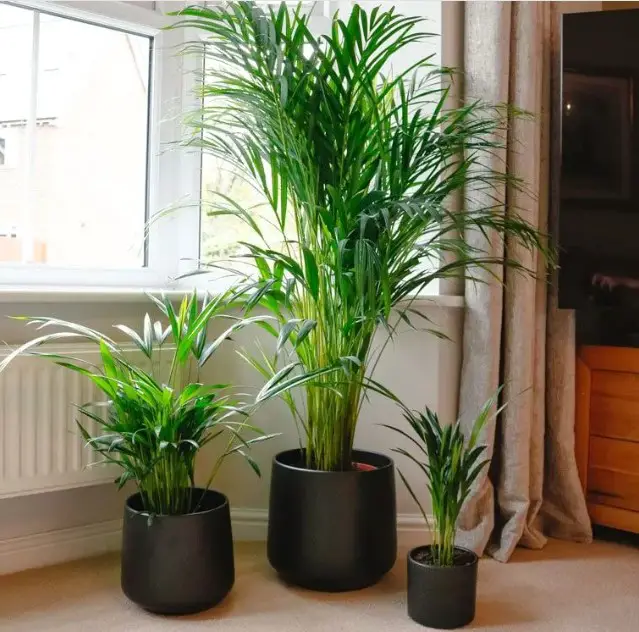The Areca palm, scientifically known as Dypsis lutescens, is one of the most beloved houseplants, revered for its lush foliage and tropical appeal. With its elegant, bamboo-like trunks and graceful fronds, the Areca palm not only enhances indoor aesthetics but also purifies the air.
This comprehensive guide will explore everything you need to know about Areca palm care, ensuring your plant thrives whether it’s indoors or outdoors.
General Characteristics of Areca Palm

Before diving into care tips, let’s familiarize ourselves with the general characteristics of the Areca palm:
- Common Names: Areca palm, bamboo palm, golden cane palm, yellow palm
- Botanical Name: Dypsis lutescens (formerly Chrysalidocarpus lutescens)
- Family: Arecaceae
- Plant Type: Perennial
- Mature Size: Indoors: 6-7 ft tall, 3-4 ft wide; Outdoors: 15-30 ft tall, 8-10 ft wide
- Sun Exposure: Full, partial
- Soil Type: Moist but well-drained
- Soil pH: Acidic to neutral
- Bloom Time: Summer
- Flower Color: Yellow
- Hardiness Zones: 10–11 (USDA)
- Native Area: Madagascar
Appearance and Growth Habit
Areca palms grow in clusters with slender trunks that can resemble bamboo. Their feathery, arching fronds add a tropical flair to any space. While they grow approximately half a foot per year indoors, they can reach significant heights outdoors in suitable climates.
Areca Palm Care Requirements
Light Conditions
Areca palms thrive in bright, indirect sunlight.
- Indoors: Position your Areca palm near a south- or west-facing window for optimal light exposure. If natural light is limited, consider using grow lights to supplement.
- Outdoors: While they can tolerate full sun, they perform best in bright, filtered sunlight, making them ideal for patios and garden beds that receive dappled light.
Soil Needs
Well-draining soil is crucial for Areca palms to thrive.
- Outdoor Soil: Rich, slightly acidic soil with good drainage is ideal.
- Indoor Potting Mix: Use a peat-based potting mix, preferably one formulated specifically for palms, which ensures adequate drainage and aeration.
Watering Practices
Areca palms prefer consistently moist soil but do not tolerate soggy conditions.
- Watering Frequency: Water your palm when the top inch of the soil feels dry. Depending on the climate and season, this typically translates to watering once a week.
- Watering Method: Ensure the pot has drainage holes to prevent root rot. Water thoroughly, allowing excess water to drain out.
Temperature and Humidity
Areca palms flourish in warm environments.
- Ideal Temperature: They prefer temperatures between 70°F and 80°F (21°C to 27°C). While they can survive brief drops to 32°F (0°C), it’s best to keep them in regions where temperatures remain above 50°F (10°C).
- Humidity: High humidity levels are essential for these palms. In dry indoor conditions, consider using a humidifier or placing a pebble tray filled with water beneath the pot to maintain moisture.
Fertilization
Being heavy feeders, Areca palms require regular fertilization during their growing season.
- Type of Fertilizer: Use a balanced, slow-release fertilizer that is high in nitrogen and potassium. You can also opt for specialized palm fertilizers.
- Application Schedule: Fertilize every 6-8 weeks during spring and summer, and refrain from fertilizing during the fall and winter months.
Pruning
Areca palms are relatively low-maintenance when it comes to pruning.
- Self-Cleaning: These palms naturally shed their brown fronds. Wait until the fronds are mostly brown before removing them, as they still contribute to the plant’s photosynthesis.
Propagation Techniques
If you want to expand your Areca palm collection, propagation can be done through root division.
Root Division Steps:
- Choose a Mature Plant: Select an Areca palm with multiple stems.
- Pre-Soak: Water the plant a day before dividing to loosen the roots.
- Remove from Pot: Gently take the palm out of its pot, tapping the sides to release the root ball.
- Clean the Roots: Shake off the old soil and rinse the roots to see where the divisions can be made.
- Divide the Plant: Use a sharp knife to cut away four to five stems from the parent plant.
- Repot: Plant the divided stems in a new pot using a mixture of regular potting soil and coarse sand (2:1 ratio). Place the pot in bright, indirect light and keep the soil moist.
Potting and Repotting Areca Palms
Areca palms prefer being somewhat root-bound, so use a pot that allows for drainage but is not excessively large.
Repotting Guidelines:
- Frequency: Repot every 2-3 years to refresh the soil and eliminate built-up salts from fertilizers.
- Pot Size: If the root ball fits comfortably in the current pot, reuse it. If not, upgrade to a pot one size larger.
- Replanting Depth: Ensure the palm is planted at the same depth as before, as this helps prevent transplant shock.
Common Pests and Plant Diseases
Areca palms are relatively resilient but can encounter some pests and diseases:
Common Pests:
- Houseplant Pests: Indoor Areca palms can attract aphids, mealybugs, scale, whiteflies, and spider mites. Regularly check your plant and treat any infestations promptly with insecticidal soap or neem oil.
Diseases:
- Lethal Yellowing: This bacterial disease can affect outdoor Areca palms, typically transmitted by insects. Unfortunately, treatment is often ineffective, so removing the infected palm is usually the best course of action.
Troubleshooting Common Issues
While Areca palms are low-maintenance, they can experience a few common problems:
Leaf Tip Burn
Brown or yellow leaf tips can occur due to:
- Environmental Stress: Chilly air or extreme temperature fluctuations can cause leaf tip burn.
- Watering Issues: Overwatering or underwatering may lead to root stress and subsequent leaf discoloration.
- Soil Conditions: Poor soil quality or compacted roots can also contribute to this problem.
Leaf Drop
If your Areca palm drops its leaves, it may be due to sudden environmental changes, inconsistent care, or inadequate light.
- Solutions: Maintain a consistent watering schedule and ensure the plant receives enough light. If relocating indoors, gradually acclimate the palm to new conditions.
Conclusion
The Areca palm (Dypsis lutescens) is a stunning and versatile plant that adds beauty and a tropical feel to any home or garden. With its air-purifying qualities, it is an ideal indoor plant that enhances your living space while being relatively easy to care for. By following the care tips outlined in this guide, you can ensure that your Areca palm remains healthy, vibrant, and flourishing for years to come. Embrace the charm of the Areca palm and enjoy its many benefits!






